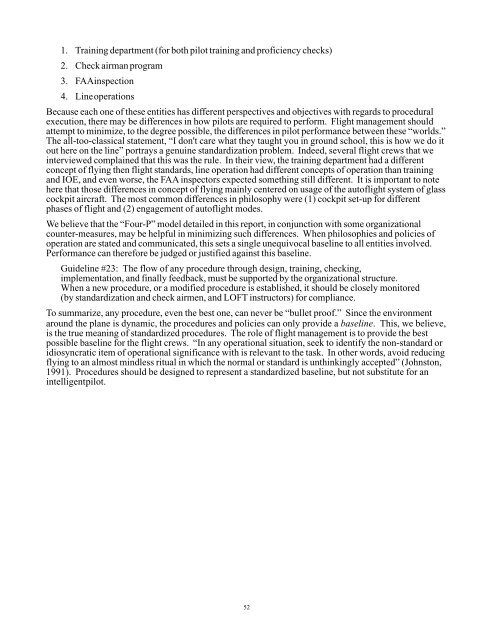On the Design of Flight-Deck Procedures - Intelligent Systems ...
On the Design of Flight-Deck Procedures - Intelligent Systems ...
On the Design of Flight-Deck Procedures - Intelligent Systems ...
Create successful ePaper yourself
Turn your PDF publications into a flip-book with our unique Google optimized e-Paper software.
1. Training department (for both pilot training and pr<strong>of</strong>iciency checks)2. Check airman program3. FAA inspection4. Line operationsBecause each one <strong>of</strong> <strong>the</strong>se entities has different perspectives and objectives with regards to proceduralexecution, <strong>the</strong>re may be differences in how pilots are required to perform. <strong>Flight</strong> management shouldattempt to minimize, to <strong>the</strong> degree possible, <strong>the</strong> differences in pilot performance between <strong>the</strong>se “worlds.”The all-too-classical statement, “I don't care what <strong>the</strong>y taught you in ground school, this is how we do itout here on <strong>the</strong> line” portrays a genuine standardization problem. Indeed, several flight crews that weinterviewed complained that this was <strong>the</strong> rule. In <strong>the</strong>ir view, <strong>the</strong> training department had a differentconcept <strong>of</strong> flying <strong>the</strong>n flight standards, line operation had different concepts <strong>of</strong> operation than trainingand IOE, and even worse, <strong>the</strong> FAA inspectors expected something still different. It is important to notehere that those differences in concept <strong>of</strong> flying mainly centered on usage <strong>of</strong> <strong>the</strong> aut<strong>of</strong>light system <strong>of</strong> glasscockpit aircraft. The most common differences in philosophy were (1) cockpit set-up for differentphases <strong>of</strong> flight and (2) engagement <strong>of</strong> aut<strong>of</strong>light modes.We believe that <strong>the</strong> “Four-P” model detailed in this report, in conjunction with some organizationalcounter-measures, may be helpful in minimizing such differences. When philosophies and policies <strong>of</strong>operation are stated and communicated, this sets a single unequivocal baseline to all entities involved.Performance can <strong>the</strong>refore be judged or justified against this baseline.Guideline #23: The flow <strong>of</strong> any procedure through design, training, checking,implementation, and finally feedback, must be supported by <strong>the</strong> organizational structure.When a new procedure, or a modified procedure is established, it should be closely monitored(by standardization and check airmen, and LOFT instructors) for compliance.To summarize, any procedure, even <strong>the</strong> best one, can never be “bullet pro<strong>of</strong>.” Since <strong>the</strong> environmentaround <strong>the</strong> plane is dynamic, <strong>the</strong> procedures and policies can only provide a baseline. This, we believe,is <strong>the</strong> true meaning <strong>of</strong> standardized procedures. The role <strong>of</strong> flight management is to provide <strong>the</strong> bestpossible baseline for <strong>the</strong> flight crews. “In any operational situation, seek to identify <strong>the</strong> non-standard oridiosyncratic item <strong>of</strong> operational significance with is relevant to <strong>the</strong> task. In o<strong>the</strong>r words, avoid reducingflying to an almost mindless ritual in which <strong>the</strong> normal or standard is unthinkingly accepted” (Johnston,1991). <strong>Procedures</strong> should be designed to represent a standardized baseline, but not substitute for anintelligent pilot.52
















